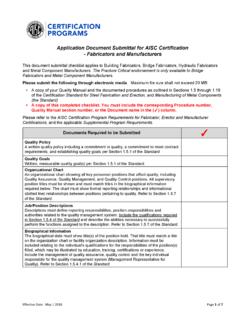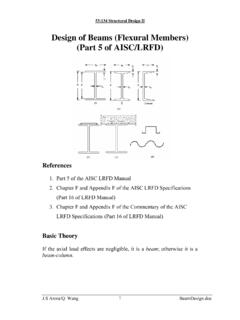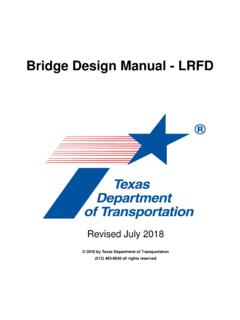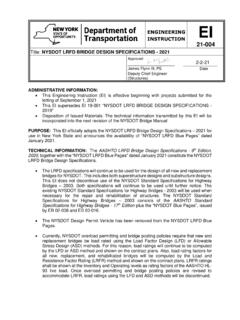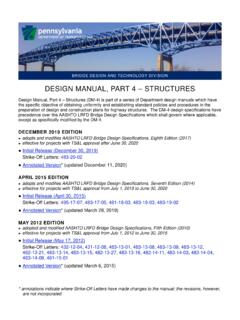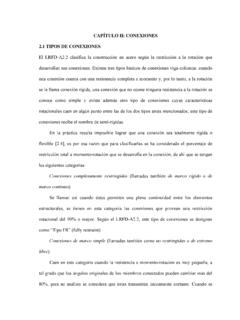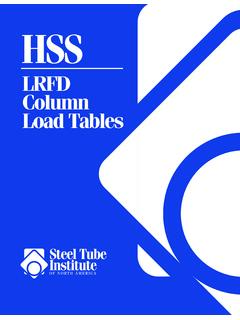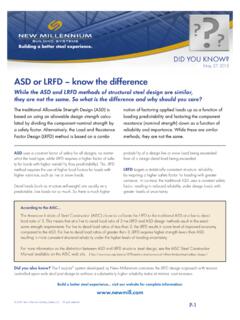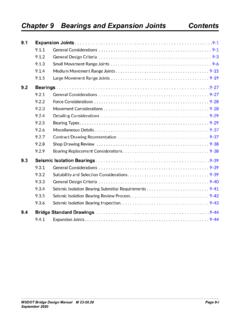Transcription of COMPANION TO THE AISC STEEL CONSTRUCTION MANUAL
1 COMPANION TO THE AISC STEEL CONSTRUCTION MANUAL Volume 1: Design Examples Version AMERICAN INSTITUTE OF STEEL CONSTRUCTION AISC 2019 by American Institute of STEEL CONSTRUCTION All rights reserved. This publication or any part thereof must not be reproduced in any form without the written permission of the publisher. The AISC logo is a registered trademark of AISC. The information presented in this publication has been prepared following recognized principles of design and CONSTRUCTION . While it is believed to be accurate, this information should not be used or relied upon for any specific application without competent professional examination and verification of its accuracy, suitability and applicability by a licensed engineer or architect.
2 The publication of this information is not a representation or warranty on the part of the American Institute of STEEL CONSTRUCTION , its officers, agents, employees or committee members, or of any other person named herein, that this information is suitable for any general or particular use, or of freedom from infringement of any patent or patents. All representations or warranties, express or implied, other than as stated above, are specifically disclaimed. Anyone making use of the information presented in this publication assumes all liability arising from such use. Caution must be exercised when relying upon standards and guidelines developed by other bodies and incorporated by reference herein since such material may be modified or amended from time to time subsequent to the printing of this edition.
3 The American Institute of STEEL CONSTRUCTION bears no responsibility for such material other than to refer to it and incorporate it by reference at the time of the initial publication of this edition. Printed in the United States of America iiAMERICAN INSTITUTE OF STEEL COMPANION , Vol. 1: Design ExamplesPREFACE The primary objective of this COMPANION is to provide guidance and additional resources of the use of the 2016 AISC Specification for Structural STEEL Buildings (ANSI/AISC 360-16) and the 15th Edition AISC STEEL CONSTRUCTION MANUAL . The COMPANION consists of design examples in Parts I, II and III. The design examples provide coverage of all applicable limit states, whether or not a particular limit state controls the design of the member or connection.
4 In addition to the examples that demonstrate the use of the AISC MANUAL tables, design examples are provided for connection designs beyond the scope of the tables in the AISC MANUAL . These design examples are intended to demonstrate an approach to the design, and are not intended to suggest that the approach presented is the only approach. The committee responsible for the development of these design examples recognizes that designers have alternate approaches that work best for them and their projects. Design approaches that differ from those presented in these examples are considered viable as long as the AISC Specification, sound engineering, and project specific requirements are satisfied.
5 Part I of these examples is organized to correspond with the organization of the AISC Specification. The Chapter titles match the corresponding chapters in the AISC Specification. Part II is devoted primarily to connection examples that draw on the tables from the AISC MANUAL , recommended design procedures, and the breadth of the AISC Specification. The chapters of Part II are labeled II-A, II-B, II-C, etc. Part III addresses aspects of design that are linked to the performance of a building as a whole. This includes coverage of lateral stability and second-order analysis, illustrated through a four-story braced-frame and moment-frame building. The Design Examples are arranged with lrfd and ASD designs presented side-by-side, for consistency with the AISC MANUAL .
6 Design with ASD and lrfd are based on the same nominal strength for each element so that the only differences between the approaches are the set of load combinations from ASCE/SEI 7-16 used for design, and whether the resistance factor for lrfd or the safety factor for ASD is used. CONVENTIONS The following conventions are used throughout these examples: 2016 AISC Specification for Structural STEEL Buildings is referred to as the AISC Specification and the15th Edition AISC STEEL CONSTRUCTION MANUAL , is referred to as the AISC 2016 ASCE Minimum Design Loads and Associated Criteria for Buildings and Other Structures isreferred to as ASCE/SEI source of equations or tabulated values taken from the AISC Specification or AISC MANUAL is notedalong the right-hand edge of the the design process differs between lrfd and ASD, the designs equations are presented rarely occurs, except when the resistance factor, , and the safety factor.
7 Are results of design equations are presented to three significant figures throughout these INSTITUTE OF STEEL COMPANION , Vol. 1: Design ExamplesACKNOWLEDGMENTS The AISC Committee on Manuals reviewed and approved of the AISC Design Examples:Mark V. Holland, Chairman Gary C. Violette, Vice Chairman Allen Adams Scott Adan Abbas Aminmansour Craig Archacki Charles J. Carter Harry A. Cole, Emeritus Brad Davis Bo Dowswell Matt Eatherton Marshall T. Ferrell, Emeritus Patrick J. Fortney Timothy P. Fraser Louis F. Geschwindner, Emeritus John L. Harris III Christopher M. Hewitt William P. Jacobs V Benjamin Kaan Ronald L. Meng Larry S. Muir Thomas M. Murray James Neary Davis G. Parsons II, Emeritus John Rolfes Rafael Sabelli Thomas J.
8 Schlafly Clifford W. Schwinger William T. Segui, Emeritus Victor Shneur William A. Thornton Michael A. West Ronald G. Yeager Cynthia J. Duncan, Secretary Eric Bolin, Assistant Secretary Michael Gannon, Assistant Secretary Carlo Lini, Assistant Secretary Jennifer Traut-Todaro, Assistant Secretary The committee gratefully acknowledges the contributions made to this document by the AISC Committee on Specifications and the following individuals: W. Scott Goodrich, Heath Mitchell, William N. Scott, Marc L. Sorenson and Sriramulu Vinnakota. ivAMERICAN INSTITUTE OF STEEL COMPANION , Vol. 1: Design ExamplesTABLE OF CONTENTS PART I EXAMPLES BASED ON THE AISC SPECIFICATION .. I-1 CHAPTER A GENERAL PROVISIONS.
9 A-1 Chapter A References .. A-2 CHAPTER B DESIGN REQUIREMENTS .. B-1 Chapter B References .. B-2 CHAPTER C DESIGN FOR STABILITY .. C-1 Example Design of a Moment Frame by the Direct Analysis Method .. C-2 Example Design of a Moment Frame by the Effective Length Method .. C-7 Example Design of a Moment Frame by the First-Order Method .. C-13 CHAPTER D DESIGN OF MEMBERS FOR TENSION .. D-1 Example W-Shape Tension Member .. D-2 Example Single-Angle Tension Member .. D-5 Example WT-Shape Tension Member .. D-8 Example Rectangular HSS Tension Member .. D-11 Example Round HSS Tension Member .. D-14 Example Double-Angle Tension Member .. D-17 Example Pin-Connected Tension Member.
10 D-20 Example Eyebar Tension Member .. D-24 Example Plate with Staggered Bolts .. D-27 CHAPTER E DESIGN OF MEMBERS FOR COMPRESSION .. E-1 Example W-Shape Column Design with Pinned Ends .. E-4 Example W-Shape Column Design with Intermediate Bracing .. E-6 Example W-Shape Available Strength Calculation .. E-8 Example W-Shape Available Strength Calculation .. E-10 Example Built-up Column with a Slender Web .. E-14 Example Built-up Column with Slender Flanges .. E-19 Example W-Shape Compression Member (Moment Frame) .. E-24 Example W-Shape Compression Member (Moment Frame) .. E-28 Example Double-Angle Compression Member without Slender Elements.




